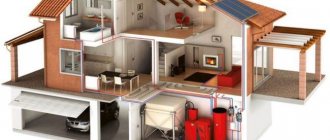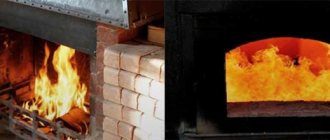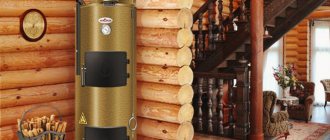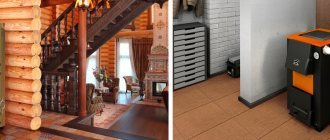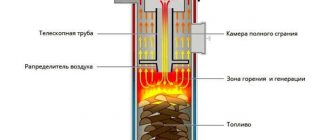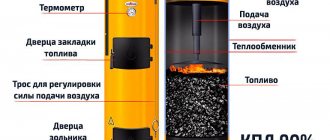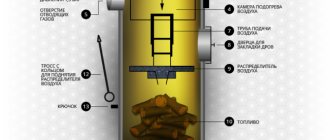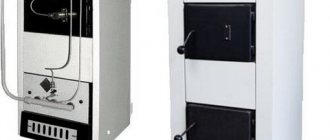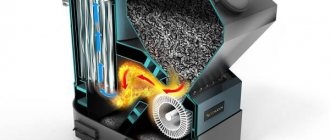A long-burning boiler is a boiler unit capable of maintaining fuel combustion and heat generation for a longer period: a day or more. Most models are designed specifically for 24-30 hours of activity. However, there are long-burning solid fuel boilers that require loading once a week, which greatly simplifies the combustion process.
To achieve such a duration of heat generation on one stack, it is important to choose not only the appropriate model, but also the type of fuel, its characteristics and fraction size.
Rating of solid fuel boilers
Manufacturers take into account customer requirements for modern technology. In addition to classic designs, the companies' catalogs now include long-burning solid fuel boilers, capable of operating for up to 36 hours on one load of coal. Pyrolysis boilers demonstrate excellent characteristics. We have studied the features and specific operation of equipment of all categories on the market. To be included in the rating, equipment had to meet strict safety requirements, have high efficiency, be functional and easy to maintain. Our team took into account user feedback, compared fuel consumption, and analyzed maintainability.
Experts paid special attention to the following characteristics:
- Recommended fuel – the combustion temperatures of wood and coal are different, this affects the choice of material for the chamber;
- Power – affects the frequency of bookmarks;
- Efficiency - the profitability of the heating system depends on this indicator;
- Volatility - automatic models are easy to use, but require increased attention to ensuring uninterrupted power supply;
- Safety – the use of thermal insulation reduces the risk of burns and ignition of building materials;
- Durability – the quality of steel and cast iron affects the service life.
Not all models met the stated characteristics and requirements of experts. Equipment with a low level of safety, high fuel consumption, and low-quality main components were excluded from our rating.
The best wood splitters
Advantages and disadvantages
Advantages of the boilers under consideration:
- high efficiency exceeding 90%;
- accessible and fairly cheap fuel;
- ease of installation, management and operation;
- almost complete combustion of combustion products;
- increased durability;
- affordable price.
Some disadvantages of TKDG should also be noted:
- the need for a separate room for installation;
- the need for periodic ash removal;
- arrangement of a storage facility for fuel supplies.
In budget designs, fuel is loaded manually, which can also be attributed to the disadvantages of such equipment.
The best long-burning solid fuel boilers
The duration of combustion on one load of fuel is one of the main selection criteria. The duration can be increased in two ways: by expanding the volume of the fuel chamber or implementing the principle of reverse combustion. The VyborExperta.ru project team analyzed 8 boilers and chose 3 models. The offered equipment is characterized by high profitability, maximum efficiency and safety.
Zota Topol-16VK
A boiler with one heating circuit with a power of 16 kW, designed for heating buildings with an area of 50 to 160 sq.m. Equipped with a built-in 29 liter boiler, designed for a maximum coolant temperature of 95 ºС. You can burn wood, coal or briquettes in the chamber. The maximum permissible pressure in the system is 3 atm.
The complex configuration of the heat exchanger and grates filled with coolant provide high efficiency. A water jacket coated with basalt cardboard helps reduce heat loss from the heat exchanger. Fuel can be loaded through a vertical or horizontal firebox. Access to the heat exchanger for cleaning is through a removable damper. The model can be equipped with a pellet burner and automated operation.
Advantages:
- Adjustable blower damper;
- The thermometer allows you to measure the temperature of the coolant;
- Improved heat transfer efficiency;
- Autonomous ash door;
- Burning time – 10-12 hours;
- Possibility of completing with heating element;
- Capacious firebox – 39 l;
- Low price.
Flaws:
- Firewood length up to 396 mm.
The model can be equipped with automation that controls combustion. The equipment regulates the air supply, maintaining optimal conditions. This allows you to increase the combustion duration on one fuel load by 70%.
Teplodar Cooper Expert-22
Floor-standing model with a power of 22 kW, intended for installation in private homes with an area of up to 220 sq.m. Works on fuel briquettes, coal and wood. Burning on one tab for up to 24 hours thanks to top combustion with three-zone air supply. The extended package includes a pre-installed heating element, a gate valve and an Italian-made thermometer to control the temperature of the coolant. All accessories for cleaning cameras are included. There are two hatches installed for cleaning.
The design allows you to install a pellet or gas burner and reconfigure the equipment in half an hour. Operates in four different modes that allow you to quickly raise the temperature in the system or ensure maximum profitability.
Advantages:
- Versatility;
- Fast heating;
- Convenient loading of fuel through the inclined door;
- A removable stainless steel tray additionally protects the firebox door from overheating;
- Manufacturer's warranty 3 years;
- Good heat dissipation.
Flaws:
- Firewood is only small in size;
- Requires regular cleaning.
NMK Magnum KDG 20 TE
The NMK company produces solid fuel boilers for homes that operate throughout the heating season without stopping for maintenance. Coal is recommended as fuel. A power of 20 kW allows you to cope with the heating of a country house with an area of 180-200 sq.m. The equipment is equipped with an automatic draft thermostat, which controls the air supply and coolant temperature. A pressure gauge on the front panel makes it easy to control operating pressure. The recommended water pressure in the circuit is no more than 2 atmospheres.
The design of the chambers and water jacket made it possible to increase the efficiency of the equipment to 80%. To maintain comfortable conditions in the off-season, you can install a heating element. Mechanical control makes the equipment completely energy independent.
Advantages:
- Low fuel consumption;
- Good level of thermal insulation;
- Works on any type of coal;
- Stylish design;
- Easy target setting of operating temperature.
Flaws:
- One type of fuel.
Popular manufacturing companies
Heating equipment is always in high demand, which is why the majority of technically developed world countries are engaged in the production of such units.
Among the foreign manufacturers, the following brands are best known::
- Stropuva - produces long-burning boilers operating on solid fuel, chimneys and water heating systems, as well as shut-off and control valves (Lithuania).
- Buderus is a German specialist in the field of heating technology.
- WATTEK is a Czech company dealing with a wide range of issues - design, production, installation and maintenance of heating equipment.
- ACV is a Belgian manufacturer of heating and hot water equipment for domestic and industrial use.
- Wirbel is a company from Austria that produces various types of heating boilers, both solid fuel and electric.
Among Russian companies producing long-burning boilers, the following manufacturers are popular among users:
- NMK , full name - Novosibirsk Metalworking Company, is engaged in the production of various products, including solid fuel boilers of the Magnum series.
- ZOTA . The production is located in Krasnoyarsk and produces equipment for plumbing, heating units, including various types of boilers.
- TK TeploGarant LLC is a company from Kostroma that produces boilers for domestic and industrial use and various components for them.
The best classic solid fuel boilers
The classic solid fuel cast iron boiler replaced the stove. The equipment has a simple design and operates on the principle of direct combustion - from bottom to top. The equipment is produced by different manufacturers: from artisanal enterprises to industry leaders. Having analyzed 9 brands, we suggest paying attention to 4 boilers with an original design, a high level of safety and good thermal insulation, which makes work more economical.
Lemax Forward-12.5
Classic single-circuit boiler with an efficiency of 75%. A power of 13 kW allows you to maintain comfort in a small house with an area of 120-130 sq.m. Firewood, coal, and anthracite can be used as fuel. Top loading made it possible to make the design as compact as possible. The body is reinforced with a channel, and 4 mm thick steel is used as the main material. To protect against corrosion, the metal is treated with inhibitors and a heat-resistant decorative coating.
The grate bars are made of gray cast iron, which is characterized by high thermal resistance. To control the temperature, a thermometer is built into the front panel. You can control the operation of the equipment using a mechanical regulator.
Advantages:
- Maximum operating time on one load is 12 hours;
- Reinforced heat exchanger;
- Non-volatility ensures complete autonomy;
- Simple connection system to an indirect heating boiler;
- Low price.
Flaws:
- Small fuel chamber size.
The boiler can be converted to use mains gas. To do this, just install a gas burner. This design feature makes the model the optimal choice for new buildings.
Bosch Solid 2000 B SFU 12
Single-circuit boiler with high efficiency, which reaches 84%. Firewood, coal, coke, wood or coal briquettes can be used as fuel. Fuel consumption 5.3 kg/hour. The primary heat exchanger is made of heat-resistant steel. It is possible to install equipment for mechanical adjustment of air supply. The ash pan door is equipped with an adjustable throttle, which simplifies the supply of primary air.
Recommended coolant temperature is 65-95 degrees. To control the main operating parameters, a thermometer and a pressure gauge are installed. Recommended water pressure in the heating circuit is 2 atmospheres.
Advantages:
- Easy maintenance;
- Vertical loading;
- Energy independence;
- Thermal insulation efficiency;
- Improved combustion chamber design.
Flaws:
- Overcharge.
Evan Warmos TT-18
Single-circuit heating boiler with power from 6 to 18 kW. The design of the grate system makes the equipment unpretentious to the fuel used. The chamber can burn wood and wood waste with a humidity of up to 70%. The spacious chamber allows you to use logs up to 55 cm long. The maximum burning time on one load is up to 15 hours when using high-quality coal.
The protective screen makes servicing safe. To control the main operating parameters, a combined thermomanometer is installed. The installation of a draft regulator is provided, which varies the power in the range from 30 to 100%. As a backup heat source, an electric heater with a temperature limiter and a thermostat is built into the boiler.
Advantages:
- Combined thermal insulation saves heat and protects against burns;
- The system for supplying heated air to the combustion zone increases the combustion duration;
- Reinforced design;
- The combustion chamber is made of heat-resistant steel;
- Easy installation.
Flaws:
- The afterburning system for pyrolysis gases becomes clogged.
Protherm Beaver 20 DLO
Single-circuit floor model, designed for heating a house with an area of 160-180 sq.m. Efficiency – 70.8% when working on coal. In this indicator it can compete with pyrolysis and gas boilers. Coal or wood is used as fuel. The coolant temperature varies from 30 to 85 degrees. The double-pass cast iron heat exchanger provides a high heating area and maximum heat transfer.
The control system consists of a draft regulator and a thermostatic regulator, the operation of which does not require electricity. Built-in thermometer and pressure gauge allow you to monitor basic operating parameters. The maximum permissible pressure in the system is 4 atmospheres. This allows you to heat a large building.
Advantages:
- Impeccable build quality;
- Quickly heats the coolant to the set temperature;
- Volumetric combustion chamber;
- Increased interval between cleanings;
- Easy maintenance.
Flaws:
- High price;
- Expensive spare parts.
Kiturami KF-35
at a price of 108,060 rub.
Koreans are famous for their passion for computerizing any equipment.
One of the latest models of the KF-35 solid fuel boiler from Kiturami is no exception. This is a double-circuit boiler with a closed combustion chamber and a cast iron heat exchanger with three combustion stages, due to which the efficiency of the installation can reach 91.5%. The model has a combustion chamber for 40 kg of fuel and is more adapted for working with wood (maximum length - 500 mm), but any other solid fuel can be used. Fine-tuning and automatic regulation of air flow ensures energy and fuel savings for boiler operation. Among the advantages of the equipment is a well-thought-out system for removing pyrogenetic water, which allows you to use even very wet firewood. Main technical characteristics of Kiturami KF-35
| Characteristics | Values |
| Rated power, kW | 24 |
| Heated area, m² | 240 |
| Efficiency, % | 91,5 |
| Fuel | firewood 100x500 mm, coal 20-40 mm, briquettes |
| Heat exchanger material | steel |
| Number of circuits | 2 |
| The combustion chamber | closed |
| Chimney diameter, mm | 150 |
| Dimensions, mm | 780x1300x1270 |
| Weight, kg | 262 |
| Homeland of the brand / Production | South Korea / South Korea |
| price, rub. | 108 060 |
Watch a video review of Kiturami KF-35 and other solid fuel boilers of this brand:
The best pyrolysis solid fuel boilers
The original system of a solid fuel boiler of this type has a two-chamber design. In the first chamber, when there is a lack of air, the fuel burns, releasing pyrolysis gas. Pyrolysis gas burns in the second chamber; this process can be regulated, which saves fuel. Two-stage combustion allows the solid fuel to burn out completely, which increases efficiency. The equipment is more comfortable to use, but requires the use of dry firewood and depends on electricity. The VyborExpert.ru team analyzed 9 models and selected 3 pyrolysis boilers, which are highly efficient, reliable and do not require complex maintenance.
Vesuvius Elbrus-10
A simple and reliable design, designed for heating a small house or cottage with an area of up to 100 sq.m. It runs on wood and coal, it is possible to install a heating element with a power of 6 kW. The recommended pressure in the system is up to 3 atmospheres. The design of the heat exchanger simplifies access for cleaning. The efficiency reaches 80%, approaching the performance of diesel fuel boilers.
The body is made of structural steel, the sealed doors are made of cast iron. The thermostat, heating element and heating system can be connected from either side of the housing. The equipment is designed to work in systems with natural and forced circulation.
Advantages:
- Precise power control helps create a comfortable microclimate;
- Effective basalt thermal insulation;
- Compact design;
- One stack of wood burns for 8 hours;
- Easy maintenance.
Flaws:
- Small volume of the chamber, which is designed for firewood 38 cm.
The model has a simple design, which allows you to do without installing a smoke exhauster powered by electricity. A non-volatile pyrolysis boiler is an economical solution for a country house and cottage in a village remote from civilization.
Burzhuy-K Standard-20
High power and efficiency of 85% allow the equipment to be used for the heating system of a house with an area of 200-220 sq.m. The heat exchanger is made of heat-resistant steel. The volumetric chamber allows the use of firewood up to 55 cm long. Works on all types of solid fuel. The maximum coolant temperature is 95 degrees, the pressure in the system can reach 4.5 atmospheres.
The model is equipped with a thermostat, a pipe for connecting a chimney with a damper. Mechanical control makes the system energy independent. Built-in thermometer and pressure gauge make it easy to control key operating parameters.
Advantages:
- Burning time on one stack of firewood is up to 12 hours;
- Low percentage of harmful emissions into the atmosphere;
- Maximum fuel burn;
- High rate of room heating;
- Manufacturer's warranty 30 months.
Flaws:
- There is no provision for connecting a heating element.
Atmos DC 32S
A powerful model designed to heat a building with an area of 250-350 sq.m. When creating, heat-resistant steel with a thickness of 3 to 8 mm is used. To increase heat transfer, ceramic blocks are used in the chamber. The power is automatically adjusted using an electromechanical damper. The regulator performs the function of overheating protection. The control thermostat controls the fan, which blows air and maintains the set temperature. It can work with the fan turned off, but the power drops to 70%.
The model can be equipped with a proprietary electronic control system that takes into account the air temperature indoors and outdoors. The microcontroller controls fans and other equipment, allowing you to save fuel and increase the burning time on one tab.
Advantages:
- Efficiency up to 90%;
- Spacious camera;
- Maximum log length 53 cm;
- Dust-free ash collection;
- The cooling circuit protects against overheating;
- Automatic shutdown when fuel burns out.
Flaws:
- High price.
Types of devices
According to the method of fuel combustion, long-burning boilers with a double circuit can be divided into:
- Pyrolysis . Equipped with two combustion chambers. In one of them, the process of smoldering and the release of gas for pyrolysis occurs, in the other, the resulting gas is mixed with oxygen and burned. Equipment of this type is characterized by high environmental friendliness - a minimal amount of harmful substances is released into the atmosphere. The combustion process produces little soot. If the boiler is equipped with automation, power adjustment will be possible.
- With upper combustion chamber . Such boilers are very easy to maintain. The amount of automation required for their stable operation is minimal; it is possible to operate in autonomous mode without electricity. There are also disadvantages - a lot of ash is generated during operation, there is a list of requirements for fuel types. For example, small wood chips or sawdust are not suitable for kindling.
- Pellet . To kindle such equipment, special pellets or compressed fuel briquettes are used. Such boilers are environmentally friendly, economical and efficient, and have a long service life. One of the main disadvantages is the high price of the boiler and the special conditions that will have to be maintained for fuel storage. The room should be dry; high air humidity will contribute to the deterioration of pellets.
How to choose a solid fuel boiler
Heating equipment must be reliable, economical, and capable of maintaining an optimal microclimate. Equipment that meets these requirements is offered by domestic and foreign companies. Which solid fuel boiler is better for a private home, and which can only cope with heating a small cottage, depends on a number of parameters taken into account when choosing a model.
Thermal power
You can buy a small, inexpensive boiler, but you need to take into account the power of the equipment. Manufacturers must indicate this characteristic in the technical documentation. The maximum area of the heated room depends on the thermal power. These parameters are directly related: per 1 kW there should not be more than 10 sq.m. premises with a ceiling height of 2.7 meters. For heating a small house of 60-70 sq.m. A boiler with a thermal power of 6-7 kW is sufficient.
Preliminary calculations are relevant for small buildings. More precise parameters should take into account the calorie content of the fuel used, the number of radiators installed, the presence of a boiler and its volume. It is recommended to order a detailed calculation of thermal power from heating engineers. This will help get rid of problems during severe frosts or when using low-calorie fuel.
Efficiency
The ratio of consumed fuel to the amount of useful heat is called efficiency. There is no equipment with 100% indicators; heat loss occurs from underburning of the emitted gases, which corresponds to the appearance of soot. Part of the thermal energy goes through the pipe, the other is spent on heating the walls and heat exchange with the air of the room where the equipment is installed. Efficiency is reduced by raw fuel and improper air supply.
The maximum efficiency is found in pyrolysis-type models; it can be made higher not only by the high combustion temperature of the gases, but also by the complete combustion of the fuel. Manufacturers increase efficiency by installing combined thermal insulation, of which the water jacket becomes part - energy is spent not on heating the air, but on increasing the temperature of the water. The higher the efficiency, the more cost-effective the heating system.
Type of fuel
It is recommended to buy a boiler that runs on an available type of fuel. Automated pellet models are attractive due to their functionality, but if you don’t have access to pellets, you can end up in a cold house. Universal models operate on coal and wood. Coal burns longer, allowing you to spend a minimum of time on maintenance. Firewood is a more affordable type of fuel.
When choosing a wood-burning model, you should take into account the recommended log size and the ability to efficiently burn raw fuel. Pyrolysis boilers operate on dry wood. If it is not possible to store fuel in a room with normal humidity, then such equipment will have to be abandoned.
Heat exchanger material
Manufacturers produce models with steel and cast iron heat exchangers. Heat exchangers made of heat-resistant steel have low inertia, are easy to maintain, light in weight and resistant to mechanical damage. Steel can be used to make structures of any complexity and improve operating parameters. Disadvantages: short service life, risk of burnout and low corrosion resistance.
Cast iron sectional heat exchangers are resistant to corrosion, acids, and high temperatures. Good heat transfer allows the use of small sections. Cast iron is a brittle material that is not resistant to sudden temperature changes. Heat exchangers are heavy and have low efficiency.
Number of heating circuits
Models with one water circuit are intended for heating only. A double-circuit boiler will provide heat and hot water. These models are more expensive, so if necessary, it is better to use equipment with the ability to connect a boiler. Heating in the summer is not always comfortable; in this situation, a solid fuel electric boiler with a heating element will help out, which will maintain the desired temperature in the hot water supply system.
Water circuit
To ensure autonomous hot water supply, in addition to the heating system, TKDG with a water circuit or double-circuit boilers are installed. Such units have 2 independent circuits for water circulation. An additional heat exchanger acts as a boiler and is intended only for heating water.
If the TKDG is connected to the water supply network, then water circulation through both circuits is ensured without forced supply, i.e. due to pressure in the water supply. When there is no centralized coolant supply, a storage tank is needed. It contains the necessary supply of water to meet demand.
The tank is usually installed above the boiler. A number of unit models have a built-in expansion tank. Forced water supply is provided by a circulation pump.
Which solid fuel boiler is better
Replacing heating equipment during the height of the winter season can lead to serious problems. To prevent this from happening, you need to be careful when buying a boiler. The equipment must run on accessible fuel, have simple and reliable functionality, and high efficiency. In this case, the property owner will be able to significantly reduce heating costs.
Our experts have analyzed the products of the best manufacturers and, depending on the specifics of use, recommend the following models:
- Zota Topol-16VK - a simple and economical model for a private home;
- Lemax Forward-12.5 - reliable equipment for the garden;
- Protherm Beaver 20 DLO - an efficient boiler for a country house;
- Vesuvius Elbrus-10 - compact equipment for a summer residence;
- Atmos DC 32 S is an economical boiler with a high degree of automation for a luxury mansion.
What kind of boiler should be capable of maintaining coziness and comfort in the house every day throughout the winter? Only the best models with easy maintenance and high energy efficiency can cope with this task.
Distinctive features
A long-burning double-circuit boiler operating on solid fuel is a modernized version of classic heating equipment.
It, among other things, also has a heat exchanger built into it, providing the home with a full-fledged hot water supply.
The design of the two-circuit model includes the following elements:
- Housing - can be made of sheet steel or cast iron. The thickness of the metal ranges from 4 to 6 mm.
- Fire chamber . Usually made from the same material as the body of the device.
- Grate type grate . It is located inside the combustion chamber; the material is cast iron. Enriches the fuel with the oxygen necessary to support combustion.
- Ash pan . Accumulates solid waste generated during combustion.
- Chimney - removes combustion products outside the room.
- "Water Shirt" . Most often it is built into the boiler body and filled with water, which receives heat from the walls, after which it enters the heating system.
- Additional heat exchanger coil - distinguishes double-circuit models from single-circuit ones. It is built into the water jacket of heating equipment to provide hot water supply to the house.
The main disadvantage of this design is the low degree of productivity . Therefore, models made of cast iron are more popular because they take longer to cool down.
Recommendations for use
When installing a boiler, attention should first of all be paid to the quality of the chimney. Stainless steel pipes with a diameter of 120 to 200 mm (depending on the model) are best suited for it. The ideal option would be a finished pipe with thermal insulation - a sandwich. Pipes with thick walls are not recommended. They take longer to warm up, and soot remains on the walls. It is necessary to clean the chimney once every 2 months.
When the boiler is turned on for the first time, an unpleasant odor may appear. Don't worry - this is normal, as special oil is applied to the metal during production. The first combustion should begin in a ventilated room, and the boiler should be turned on at maximum power. The duration of its operation in this mode is 1 hour.
The fuel is placed in the chamber in a loose layer so that there is an air gap between the firewood. This will allow them to ignite better. To control the combustion process in the ash chamber, the damper opens and closes.
Cleaning the boiler is allowed only after it has completely cooled down. During cleaning, it is recommended to leave some of the ash on the grate, which will serve as natural thermal insulation. This will extend the life of the element. To clean the boiler itself, use a wire brush or scraper. The smoke damper must be open at this time.
Depending on what fuel is used, a certain amount of soot is formed during boiler operation. Coniferous wood produces more waste. Sometimes condensation may form in the chimney: this depends on the level of thermal insulation and the moisture content of the fuel. To reduce the soot layer, it is recommended to use aspen firewood.
